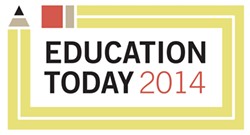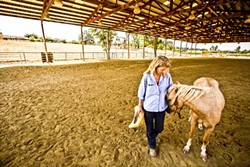
Pearl is just the kind of 13-year-old a teacher would love to have in the classroom: She isn’t shy, she’s quite curious, and she keeps quiet most of the time. She’s smart and isn’t afraid to get to know new people.
But when school is back in session, Pearl won’t be anywhere near a classroom.
That’s because Pearl is a horse.
During their summer of freedom from those pesky tests and take-home assignments, some children have joined Pearl in an arena in South Atascadero for a program that uses Equine Guided Learning to impart valuable skills and self-awareness that may be helpful come the looming school year.
Janine Asante runs the summer activity for kids as part of her Herds of Wisdom program. The licensed marriage and family therapist uses her background in therapy and a love for horses to bring a different approach to childhood and educational development. There are plenty of benefits to the alternative methods of horse therapy, Asante says, and for the children who participate in the program, it really helps them prepare for upcoming challenges and become more self-aware. Maybe it’s the terrifying transition from a familiar elementary school to a big, wide-open middle school; maybe it’s adapting to the growing pains of puberty.
“Kids always like to come here because of the horse, no doubt,” Asante said. “It makes it more palatable to them, that they’re learning skills but don’t realize it.”

- PHOTO BY HENRY BRUINGTON
- PEOPLE PONY: Janine Asante and her horse, Pearl, have been working with kids over the summer to take them through a slightly unorthodox method of experiential learning.
There are a number of goals horse therapy can help kids achieve. In general, Asante said the activity helps people work with social anxiety or psychological conditions that may hinder learning, communication, and social interaction. Asante, who also conducts more traditional psychotherapy indoors, practices Equine Assisted Therapy with a variety of clientele to address different therapeutic needs. She’s worked with military veterans, at-risk youth, couples and families, adopted children and their parents, and people diagnosed with Post Traumatic Stress Syndrome. Victims of abuse and other forms of trauma have joined Asante in the arena to begin the healing process alongside a horse. Her focus on prevention is especially helpful for children stepping into a big world where plenty of pressures and distractions can pose a challenge to learning and maturing.
Children ages 7 to 14 have participated in her camps over the summer, working primarily with Pearl, a 10-hand (about 4 feet tall) horse Asante thinks is part Shetland pony, part miniature horse. Asante attributes particular significance to the years right before high school, helping the kids prepare for a time when the choices they make and the grades they get can have huge impacts on the path ahead.
In the arena, children participate in several exercises alongside a horse, with a focus on non-verbal communication and trust building. One of Asante’s favorites is a carrot-laced obstacle course, where the kids guide the horse while avoiding the delicious vegetables meant to lead the horse astray. The carrots represent distractions that kids often face. In this case, the kids choose three common distractions: television, their friends, and feelings of fear and anxiety. Teaching them to stay focused in the obstacle course can be applied to a scenario where they may have to say to their friends: “Sorry, but I can’t come out and play right now, because I have to study for my test.”
While there’s certainly some very technical, sophisticated analysis of why horse therapy does what it does, the work seems quite natural on the surface and, for lack of a better word, Zen. Horses have very strong personalities and are sensitive to body language and non-verbal communication. They can sense the energy of humans and will react to unsettled feelings or hidden agendas. Put in a therapeutic practice, these instincts help draw out and magnify certain tendencies or repressed feelings with which a person may be dealing. This process can help people to reconsider and hone in on how they interact with other beings, becoming more aware of projected emotions that mentally may be rationalized away.
“With a big animal, they learn really quick that they can’t get away with the things that they can get away with through talking,” Asante said. “Because we’re all human, we’re really good at talking in circles.”
Last year, Asante worked with a group of 9- to 14-year-old students from the Tachi Native American Reservation in Kings County. The kids in the program were struggling with school and had poor attendance and grades. More traditional, institutionally based methods of addressing the behavior proved unsuccessful, so the school brought her and her horses in.
“Nothing else was really getting through to them,” Asante said.
As a result, grades improved, attendance went up, and there were fewer instances of the kids getting called into the counselor’s office, she explained.
In the modern age, when scores of children fall between the cracks while debates are waged about standardized testing, the application of technology, and new educational methods like common core, the oval-shaped piece of dirt where Asante does her work is just one tiny part of the bigger picture.
“There’s a lot of work to be done,” Asante said. “There’s a lot of populations that really need this kind of work.”
Contact Staff Writer Jono Kinkade at [email protected].
-- Melody DeMeritt - former city council member, Morro Bay
Comments